Applying Contract Conditions & Quality Assurance in Construction
VerifiedAdded on 2023/05/30
|6
|1805
|482
Report
AI Summary
This assignment provides a comprehensive overview of contract conditions and quality assurance in building construction projects. It identifies key government agencies and authorities involved in the construction process, detailing the information required from each and the necessary licenses or permits. The report also lists essential building professionals and trades associated with construction, emphasizing the importance of quality assurance and continuous improvement. It discusses the role of quality management systems, project finalization reviews, and client satisfaction in achieving project goals and adhering to quality policies and procedures. Furthermore, the assignment explores the significance of construction audits, risk management planning, and performance measures in ensuring project completion within budget and compliance with quality standards. Desklib offers a wealth of similar solved assignments and study resources for students.
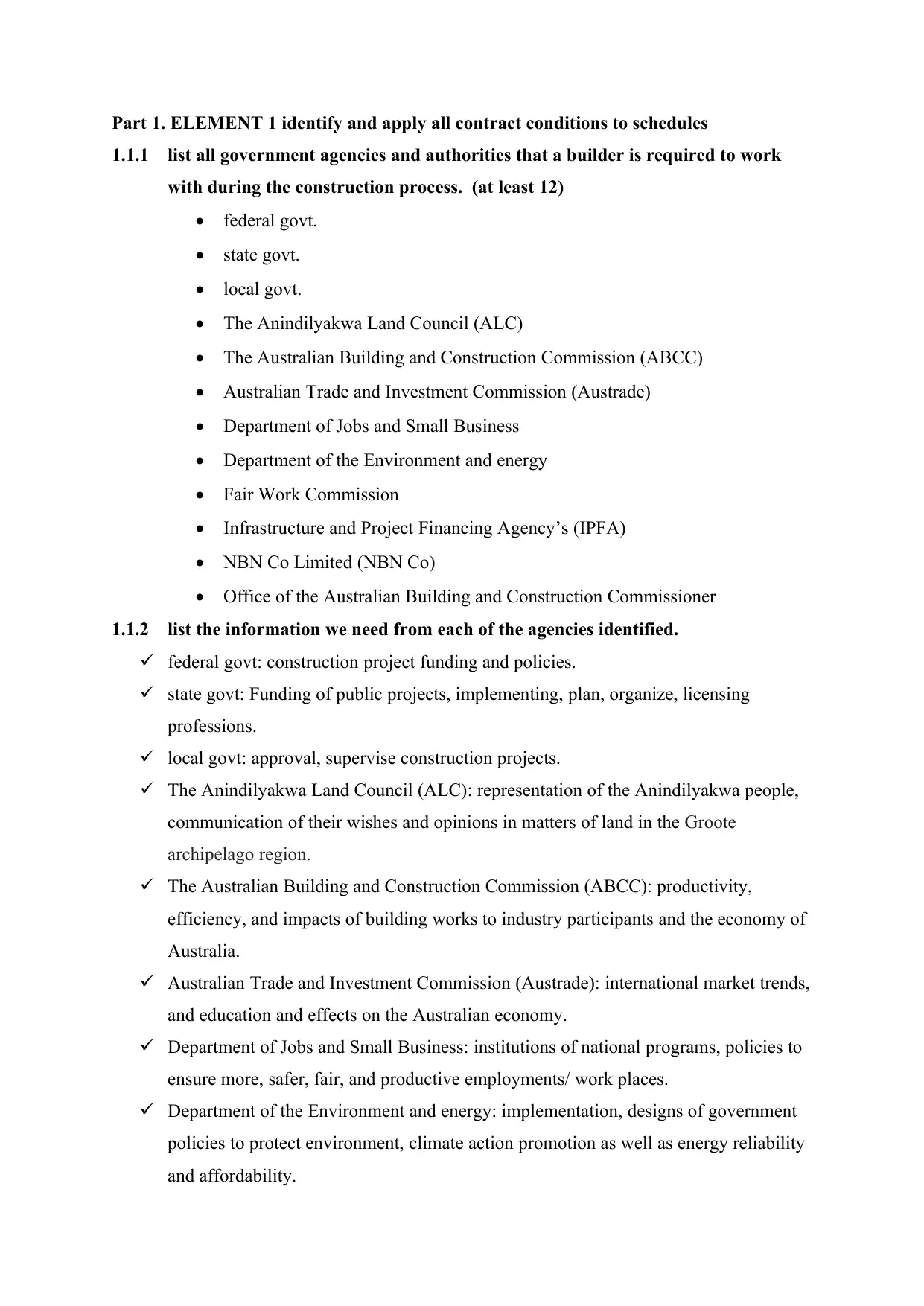
Part 1. ELEMENT 1 identify and apply all contract conditions to schedules
1.1.1 list all government agencies and authorities that a builder is required to work
with during the construction process. (at least 12)
federal govt.
state govt.
local govt.
The Anindilyakwa Land Council (ALC)
The Australian Building and Construction Commission (ABCC)
Australian Trade and Investment Commission (Austrade)
Department of Jobs and Small Business
Department of the Environment and energy
Fair Work Commission
Infrastructure and Project Financing Agency’s (IPFA)
NBN Co Limited (NBN Co)
Office of the Australian Building and Construction Commissioner
1.1.2 list the information we need from each of the agencies identified.
federal govt: construction project funding and policies.
state govt: Funding of public projects, implementing, plan, organize, licensing
professions.
local govt: approval, supervise construction projects.
The Anindilyakwa Land Council (ALC): representation of the Anindilyakwa people,
communication of their wishes and opinions in matters of land in the Groote
archipelago region.
The Australian Building and Construction Commission (ABCC): productivity,
efficiency, and impacts of building works to industry participants and the economy of
Australia.
Australian Trade and Investment Commission (Austrade): international market trends,
and education and effects on the Australian economy.
Department of Jobs and Small Business: institutions of national programs, policies to
ensure more, safer, fair, and productive employments/ work places.
Department of the Environment and energy: implementation, designs of government
policies to protect environment, climate action promotion as well as energy reliability
and affordability.
1.1.1 list all government agencies and authorities that a builder is required to work
with during the construction process. (at least 12)
federal govt.
state govt.
local govt.
The Anindilyakwa Land Council (ALC)
The Australian Building and Construction Commission (ABCC)
Australian Trade and Investment Commission (Austrade)
Department of Jobs and Small Business
Department of the Environment and energy
Fair Work Commission
Infrastructure and Project Financing Agency’s (IPFA)
NBN Co Limited (NBN Co)
Office of the Australian Building and Construction Commissioner
1.1.2 list the information we need from each of the agencies identified.
federal govt: construction project funding and policies.
state govt: Funding of public projects, implementing, plan, organize, licensing
professions.
local govt: approval, supervise construction projects.
The Anindilyakwa Land Council (ALC): representation of the Anindilyakwa people,
communication of their wishes and opinions in matters of land in the Groote
archipelago region.
The Australian Building and Construction Commission (ABCC): productivity,
efficiency, and impacts of building works to industry participants and the economy of
Australia.
Australian Trade and Investment Commission (Austrade): international market trends,
and education and effects on the Australian economy.
Department of Jobs and Small Business: institutions of national programs, policies to
ensure more, safer, fair, and productive employments/ work places.
Department of the Environment and energy: implementation, designs of government
policies to protect environment, climate action promotion as well as energy reliability
and affordability.
Paraphrase This Document
Need a fresh take? Get an instant paraphrase of this document with our AI Paraphraser
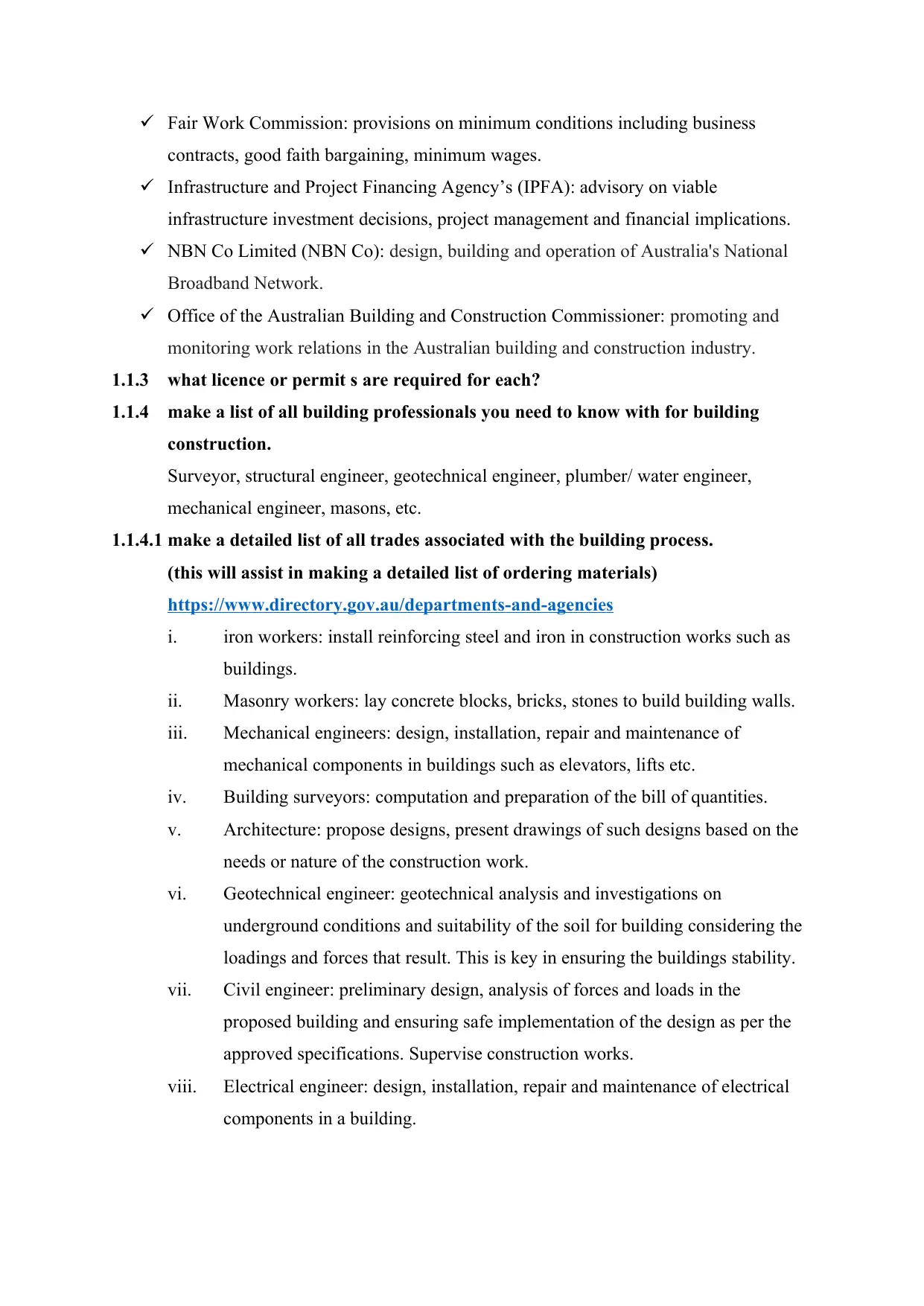
Fair Work Commission: provisions on minimum conditions including business
contracts, good faith bargaining, minimum wages.
Infrastructure and Project Financing Agency’s (IPFA): advisory on viable
infrastructure investment decisions, project management and financial implications.
NBN Co Limited (NBN Co): design, building and operation of Australia's National
Broadband Network.
Office of the Australian Building and Construction Commissioner: promoting and
monitoring work relations in the Australian building and construction industry.
1.1.3 what licence or permit s are required for each?
1.1.4 make a list of all building professionals you need to know with for building
construction.
Surveyor, structural engineer, geotechnical engineer, plumber/ water engineer,
mechanical engineer, masons, etc.
1.1.4.1 make a detailed list of all trades associated with the building process.
(this will assist in making a detailed list of ordering materials)
https://www.directory.gov.au/departments-and-agencies
i. iron workers: install reinforcing steel and iron in construction works such as
buildings.
ii. Masonry workers: lay concrete blocks, bricks, stones to build building walls.
iii. Mechanical engineers: design, installation, repair and maintenance of
mechanical components in buildings such as elevators, lifts etc.
iv. Building surveyors: computation and preparation of the bill of quantities.
v. Architecture: propose designs, present drawings of such designs based on the
needs or nature of the construction work.
vi. Geotechnical engineer: geotechnical analysis and investigations on
underground conditions and suitability of the soil for building considering the
loadings and forces that result. This is key in ensuring the buildings stability.
vii. Civil engineer: preliminary design, analysis of forces and loads in the
proposed building and ensuring safe implementation of the design as per the
approved specifications. Supervise construction works.
viii. Electrical engineer: design, installation, repair and maintenance of electrical
components in a building.
contracts, good faith bargaining, minimum wages.
Infrastructure and Project Financing Agency’s (IPFA): advisory on viable
infrastructure investment decisions, project management and financial implications.
NBN Co Limited (NBN Co): design, building and operation of Australia's National
Broadband Network.
Office of the Australian Building and Construction Commissioner: promoting and
monitoring work relations in the Australian building and construction industry.
1.1.3 what licence or permit s are required for each?
1.1.4 make a list of all building professionals you need to know with for building
construction.
Surveyor, structural engineer, geotechnical engineer, plumber/ water engineer,
mechanical engineer, masons, etc.
1.1.4.1 make a detailed list of all trades associated with the building process.
(this will assist in making a detailed list of ordering materials)
https://www.directory.gov.au/departments-and-agencies
i. iron workers: install reinforcing steel and iron in construction works such as
buildings.
ii. Masonry workers: lay concrete blocks, bricks, stones to build building walls.
iii. Mechanical engineers: design, installation, repair and maintenance of
mechanical components in buildings such as elevators, lifts etc.
iv. Building surveyors: computation and preparation of the bill of quantities.
v. Architecture: propose designs, present drawings of such designs based on the
needs or nature of the construction work.
vi. Geotechnical engineer: geotechnical analysis and investigations on
underground conditions and suitability of the soil for building considering the
loadings and forces that result. This is key in ensuring the buildings stability.
vii. Civil engineer: preliminary design, analysis of forces and loads in the
proposed building and ensuring safe implementation of the design as per the
approved specifications. Supervise construction works.
viii. Electrical engineer: design, installation, repair and maintenance of electrical
components in a building.
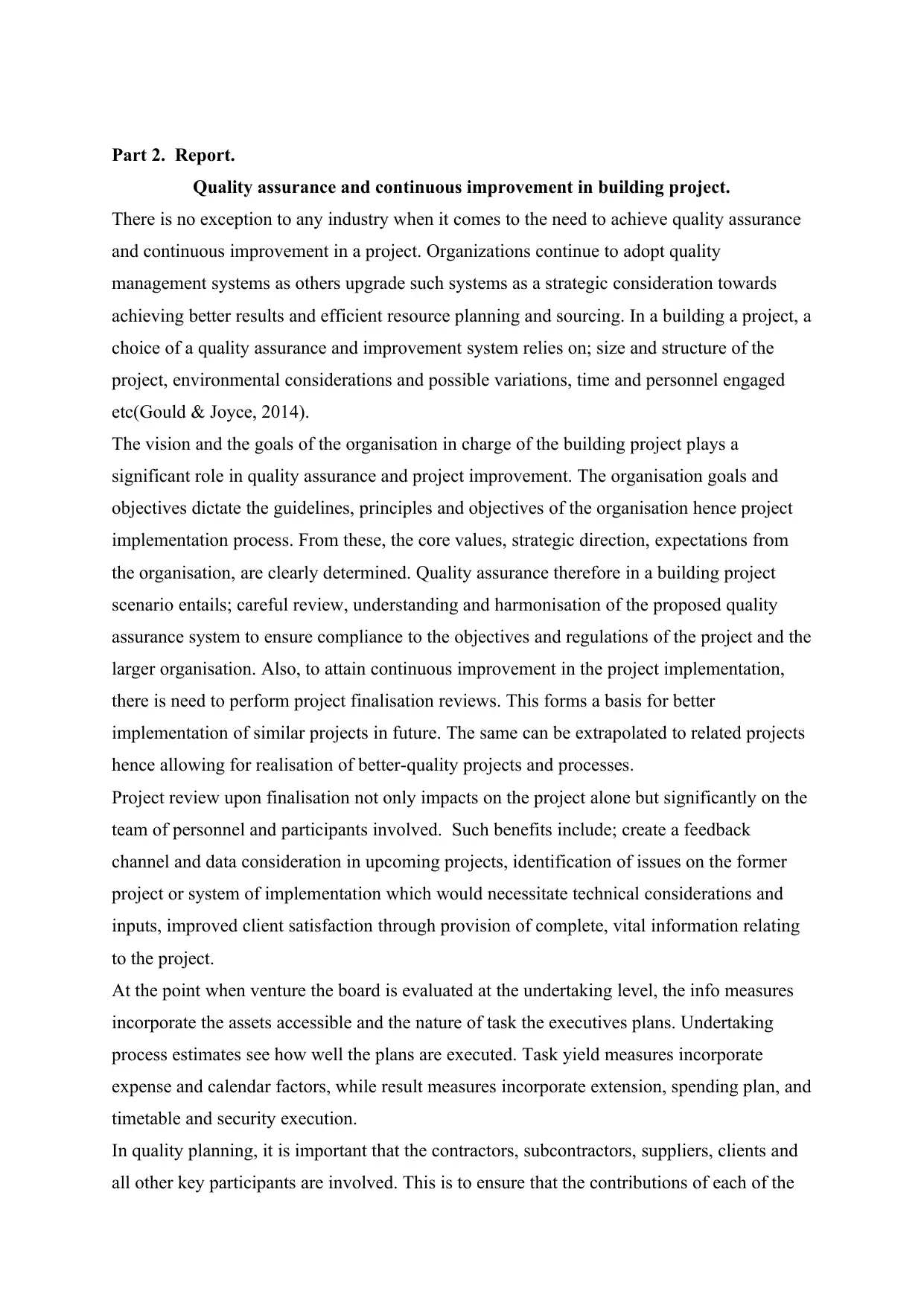
Part 2. Report.
Quality assurance and continuous improvement in building project.
There is no exception to any industry when it comes to the need to achieve quality assurance
and continuous improvement in a project. Organizations continue to adopt quality
management systems as others upgrade such systems as a strategic consideration towards
achieving better results and efficient resource planning and sourcing. In a building a project, a
choice of a quality assurance and improvement system relies on; size and structure of the
project, environmental considerations and possible variations, time and personnel engaged
etc(Gould & Joyce, 2014).
The vision and the goals of the organisation in charge of the building project plays a
significant role in quality assurance and project improvement. The organisation goals and
objectives dictate the guidelines, principles and objectives of the organisation hence project
implementation process. From these, the core values, strategic direction, expectations from
the organisation, are clearly determined. Quality assurance therefore in a building project
scenario entails; careful review, understanding and harmonisation of the proposed quality
assurance system to ensure compliance to the objectives and regulations of the project and the
larger organisation. Also, to attain continuous improvement in the project implementation,
there is need to perform project finalisation reviews. This forms a basis for better
implementation of similar projects in future. The same can be extrapolated to related projects
hence allowing for realisation of better-quality projects and processes.
Project review upon finalisation not only impacts on the project alone but significantly on the
team of personnel and participants involved. Such benefits include; create a feedback
channel and data consideration in upcoming projects, identification of issues on the former
project or system of implementation which would necessitate technical considerations and
inputs, improved client satisfaction through provision of complete, vital information relating
to the project.
At the point when venture the board is evaluated at the undertaking level, the info measures
incorporate the assets accessible and the nature of task the executives plans. Undertaking
process estimates see how well the plans are executed. Task yield measures incorporate
expense and calendar factors, while result measures incorporate extension, spending plan, and
timetable and security execution.
In quality planning, it is important that the contractors, subcontractors, suppliers, clients and
all other key participants are involved. This is to ensure that the contributions of each of the
Quality assurance and continuous improvement in building project.
There is no exception to any industry when it comes to the need to achieve quality assurance
and continuous improvement in a project. Organizations continue to adopt quality
management systems as others upgrade such systems as a strategic consideration towards
achieving better results and efficient resource planning and sourcing. In a building a project, a
choice of a quality assurance and improvement system relies on; size and structure of the
project, environmental considerations and possible variations, time and personnel engaged
etc(Gould & Joyce, 2014).
The vision and the goals of the organisation in charge of the building project plays a
significant role in quality assurance and project improvement. The organisation goals and
objectives dictate the guidelines, principles and objectives of the organisation hence project
implementation process. From these, the core values, strategic direction, expectations from
the organisation, are clearly determined. Quality assurance therefore in a building project
scenario entails; careful review, understanding and harmonisation of the proposed quality
assurance system to ensure compliance to the objectives and regulations of the project and the
larger organisation. Also, to attain continuous improvement in the project implementation,
there is need to perform project finalisation reviews. This forms a basis for better
implementation of similar projects in future. The same can be extrapolated to related projects
hence allowing for realisation of better-quality projects and processes.
Project review upon finalisation not only impacts on the project alone but significantly on the
team of personnel and participants involved. Such benefits include; create a feedback
channel and data consideration in upcoming projects, identification of issues on the former
project or system of implementation which would necessitate technical considerations and
inputs, improved client satisfaction through provision of complete, vital information relating
to the project.
At the point when venture the board is evaluated at the undertaking level, the info measures
incorporate the assets accessible and the nature of task the executives plans. Undertaking
process estimates see how well the plans are executed. Task yield measures incorporate
expense and calendar factors, while result measures incorporate extension, spending plan, and
timetable and security execution.
In quality planning, it is important that the contractors, subcontractors, suppliers, clients and
all other key participants are involved. This is to ensure that the contributions of each of the
⊘ This is a preview!⊘
Do you want full access?
Subscribe today to unlock all pages.

Trusted by 1+ million students worldwide
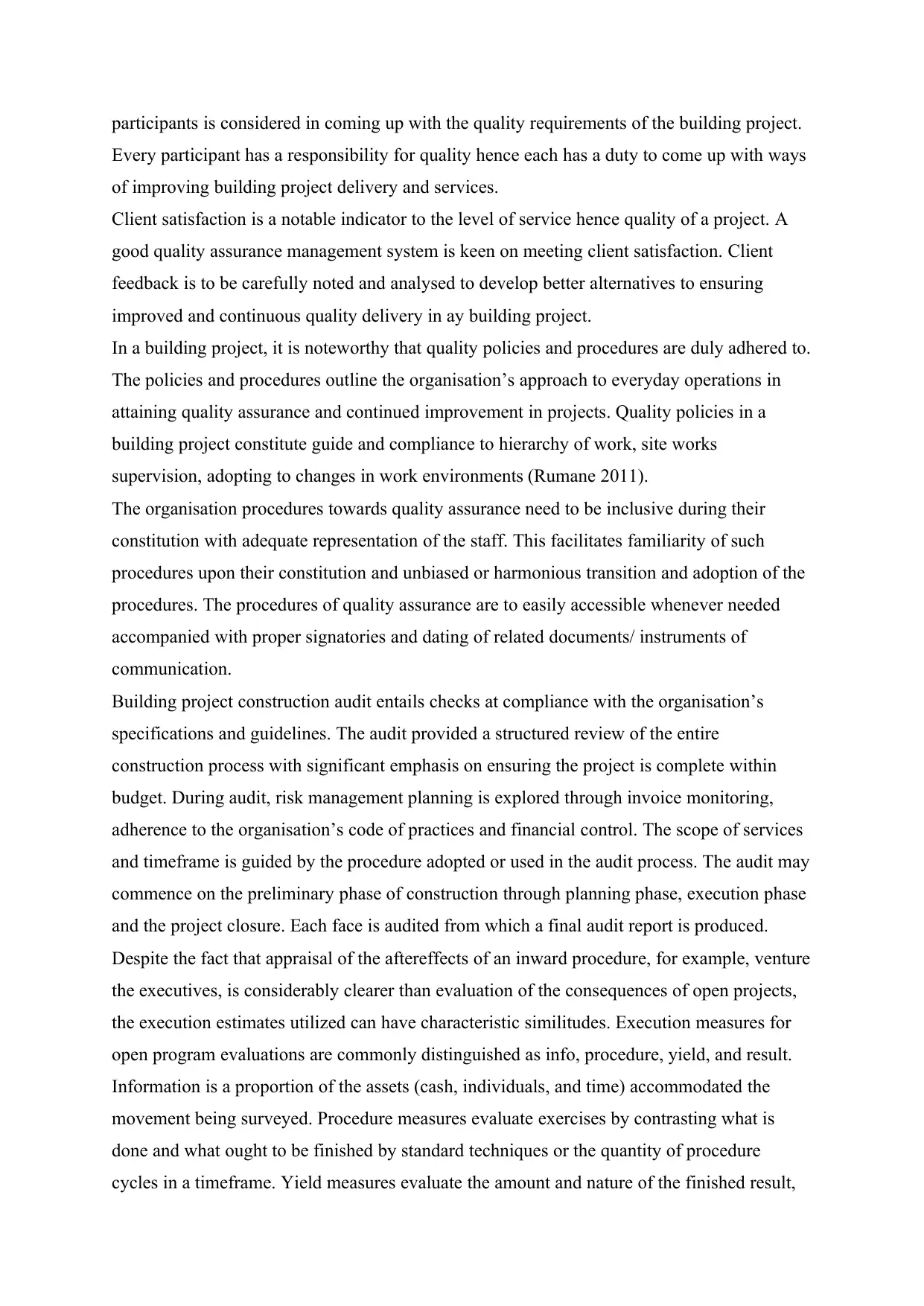
participants is considered in coming up with the quality requirements of the building project.
Every participant has a responsibility for quality hence each has a duty to come up with ways
of improving building project delivery and services.
Client satisfaction is a notable indicator to the level of service hence quality of a project. A
good quality assurance management system is keen on meeting client satisfaction. Client
feedback is to be carefully noted and analysed to develop better alternatives to ensuring
improved and continuous quality delivery in ay building project.
In a building project, it is noteworthy that quality policies and procedures are duly adhered to.
The policies and procedures outline the organisation’s approach to everyday operations in
attaining quality assurance and continued improvement in projects. Quality policies in a
building project constitute guide and compliance to hierarchy of work, site works
supervision, adopting to changes in work environments (Rumane 2011).
The organisation procedures towards quality assurance need to be inclusive during their
constitution with adequate representation of the staff. This facilitates familiarity of such
procedures upon their constitution and unbiased or harmonious transition and adoption of the
procedures. The procedures of quality assurance are to easily accessible whenever needed
accompanied with proper signatories and dating of related documents/ instruments of
communication.
Building project construction audit entails checks at compliance with the organisation’s
specifications and guidelines. The audit provided a structured review of the entire
construction process with significant emphasis on ensuring the project is complete within
budget. During audit, risk management planning is explored through invoice monitoring,
adherence to the organisation’s code of practices and financial control. The scope of services
and timeframe is guided by the procedure adopted or used in the audit process. The audit may
commence on the preliminary phase of construction through planning phase, execution phase
and the project closure. Each face is audited from which a final audit report is produced.
Despite the fact that appraisal of the aftereffects of an inward procedure, for example, venture
the executives, is considerably clearer than evaluation of the consequences of open projects,
the execution estimates utilized can have characteristic similitudes. Execution measures for
open program evaluations are commonly distinguished as info, procedure, yield, and result.
Information is a proportion of the assets (cash, individuals, and time) accommodated the
movement being surveyed. Procedure measures evaluate exercises by contrasting what is
done and what ought to be finished by standard techniques or the quantity of procedure
cycles in a timeframe. Yield measures evaluate the amount and nature of the finished result,
Every participant has a responsibility for quality hence each has a duty to come up with ways
of improving building project delivery and services.
Client satisfaction is a notable indicator to the level of service hence quality of a project. A
good quality assurance management system is keen on meeting client satisfaction. Client
feedback is to be carefully noted and analysed to develop better alternatives to ensuring
improved and continuous quality delivery in ay building project.
In a building project, it is noteworthy that quality policies and procedures are duly adhered to.
The policies and procedures outline the organisation’s approach to everyday operations in
attaining quality assurance and continued improvement in projects. Quality policies in a
building project constitute guide and compliance to hierarchy of work, site works
supervision, adopting to changes in work environments (Rumane 2011).
The organisation procedures towards quality assurance need to be inclusive during their
constitution with adequate representation of the staff. This facilitates familiarity of such
procedures upon their constitution and unbiased or harmonious transition and adoption of the
procedures. The procedures of quality assurance are to easily accessible whenever needed
accompanied with proper signatories and dating of related documents/ instruments of
communication.
Building project construction audit entails checks at compliance with the organisation’s
specifications and guidelines. The audit provided a structured review of the entire
construction process with significant emphasis on ensuring the project is complete within
budget. During audit, risk management planning is explored through invoice monitoring,
adherence to the organisation’s code of practices and financial control. The scope of services
and timeframe is guided by the procedure adopted or used in the audit process. The audit may
commence on the preliminary phase of construction through planning phase, execution phase
and the project closure. Each face is audited from which a final audit report is produced.
Despite the fact that appraisal of the aftereffects of an inward procedure, for example, venture
the executives, is considerably clearer than evaluation of the consequences of open projects,
the execution estimates utilized can have characteristic similitudes. Execution measures for
open program evaluations are commonly distinguished as info, procedure, yield, and result.
Information is a proportion of the assets (cash, individuals, and time) accommodated the
movement being surveyed. Procedure measures evaluate exercises by contrasting what is
done and what ought to be finished by standard techniques or the quantity of procedure
cycles in a timeframe. Yield measures evaluate the amount and nature of the finished result,
Paraphrase This Document
Need a fresh take? Get an instant paraphrase of this document with our AI Paraphraser
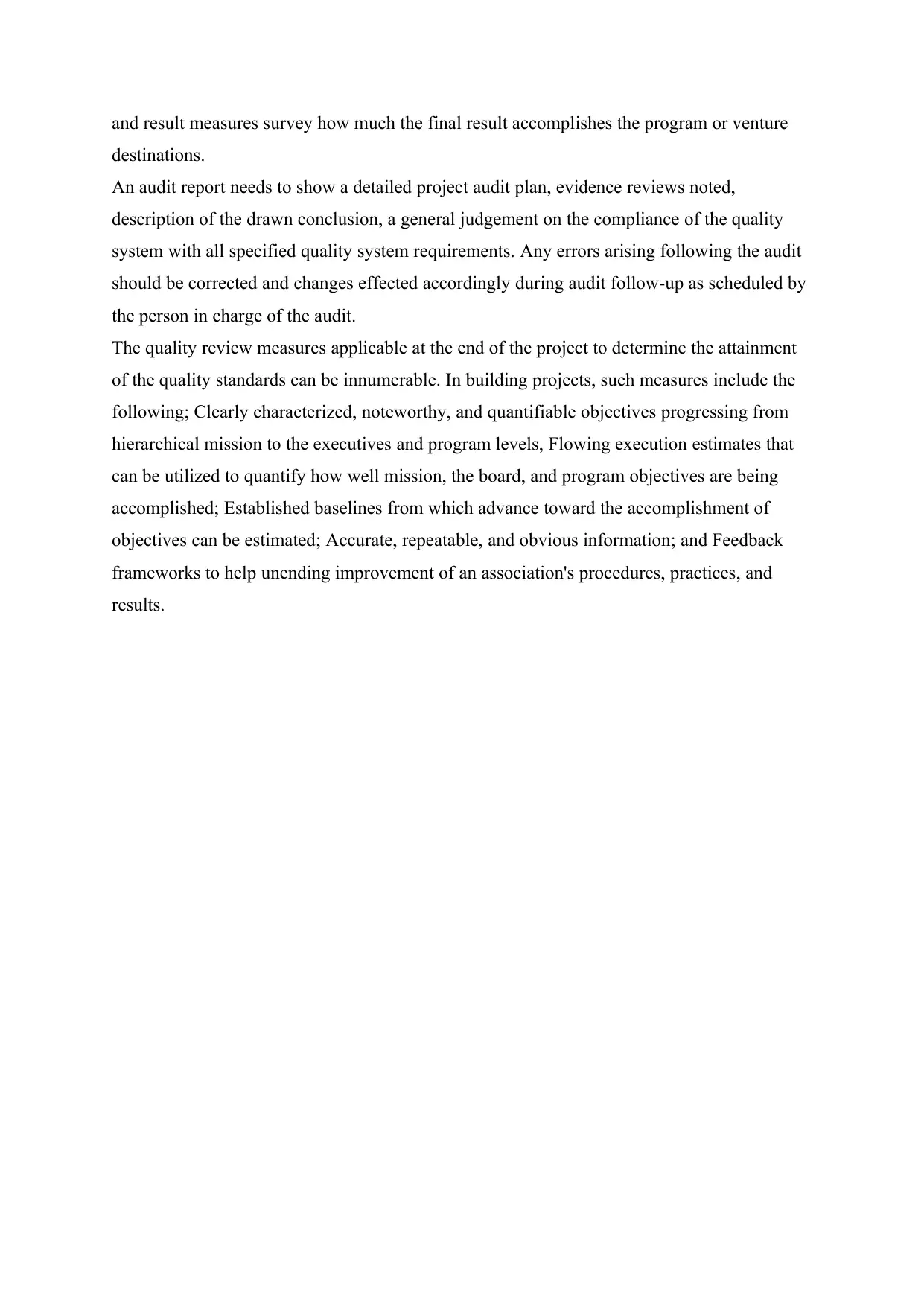
and result measures survey how much the final result accomplishes the program or venture
destinations.
An audit report needs to show a detailed project audit plan, evidence reviews noted,
description of the drawn conclusion, a general judgement on the compliance of the quality
system with all specified quality system requirements. Any errors arising following the audit
should be corrected and changes effected accordingly during audit follow-up as scheduled by
the person in charge of the audit.
The quality review measures applicable at the end of the project to determine the attainment
of the quality standards can be innumerable. In building projects, such measures include the
following; Clearly characterized, noteworthy, and quantifiable objectives progressing from
hierarchical mission to the executives and program levels, Flowing execution estimates that
can be utilized to quantify how well mission, the board, and program objectives are being
accomplished; Established baselines from which advance toward the accomplishment of
objectives can be estimated; Accurate, repeatable, and obvious information; and Feedback
frameworks to help unending improvement of an association's procedures, practices, and
results.
destinations.
An audit report needs to show a detailed project audit plan, evidence reviews noted,
description of the drawn conclusion, a general judgement on the compliance of the quality
system with all specified quality system requirements. Any errors arising following the audit
should be corrected and changes effected accordingly during audit follow-up as scheduled by
the person in charge of the audit.
The quality review measures applicable at the end of the project to determine the attainment
of the quality standards can be innumerable. In building projects, such measures include the
following; Clearly characterized, noteworthy, and quantifiable objectives progressing from
hierarchical mission to the executives and program levels, Flowing execution estimates that
can be utilized to quantify how well mission, the board, and program objectives are being
accomplished; Established baselines from which advance toward the accomplishment of
objectives can be estimated; Accurate, repeatable, and obvious information; and Feedback
frameworks to help unending improvement of an association's procedures, practices, and
results.

References
Gould, F.E. and Joyce, N.E., 2014. Construction project management. London, United
Kingdom: Pearson publishers.
Rumane, A.R., 2011. Quality management in construction projects. Boca Raton, Fla: CRC
Press.
Gould, F.E. and Joyce, N.E., 2014. Construction project management. London, United
Kingdom: Pearson publishers.
Rumane, A.R., 2011. Quality management in construction projects. Boca Raton, Fla: CRC
Press.
⊘ This is a preview!⊘
Do you want full access?
Subscribe today to unlock all pages.

Trusted by 1+ million students worldwide
1 out of 6
Your All-in-One AI-Powered Toolkit for Academic Success.
+13062052269
info@desklib.com
Available 24*7 on WhatsApp / Email
![[object Object]](/_next/static/media/star-bottom.7253800d.svg)
Unlock your academic potential
Copyright © 2020–2025 A2Z Services. All Rights Reserved. Developed and managed by ZUCOL.
